Apple HomePod Review
- Incredible sound for the footprint
- Apple Music voice control is quick and easy
- Setup is ridiculously fast
- Clean design and quality construction
- Non-Apple music sources are second-class citizens
- Siri isn't as strong as an assistant
- Stereo pairing and multi-room aren't ready at launch
- Android users are left out in the cold
- iPhone integration is single-user only
Apple's HomePod may be late to the party, but the Siri-powered smart speaker isn't arriving quietly in any sense of the word. HomePod's biggest strength is that, in a segment where ease of use is yet to catch up with functionality, it makes navigating a great-sounding Apple Music experience by voice a joy. How it does that, though, feels like classic Apple at its most demanding.
Design and Setup
The 7-inch tall HomePod is both smaller than it looks in photos and, more oddly, denser than you'd expect. The fabric cover – available in White or Space Gray – is pleasingly textured, like an expensive air filter for a performance engine. I feel weird praising a cable, but Apple's fabric-covered cord is far nicer than the rubbery snakes that emerge from the rump of most home electronics, too. If there's a downside, it's that the glossy plastic top panel is a glutton for fingerprints and smudges, at least in Space Gray form.
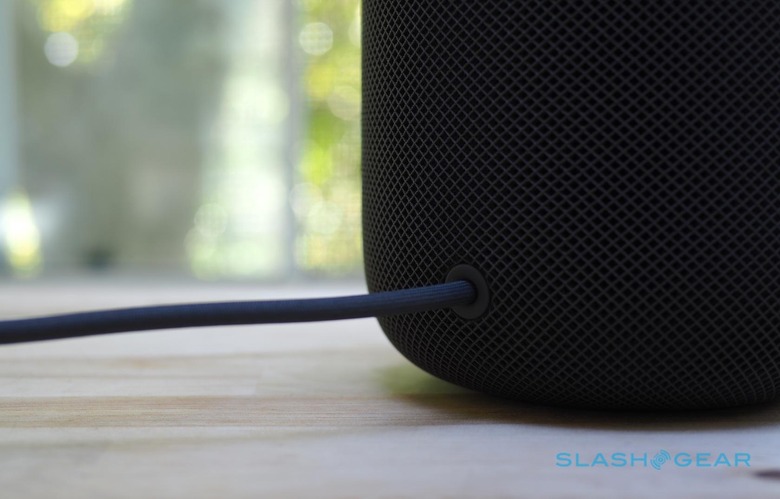
Bar the power cable, everything else is handled wirelessly, for better or worse. Not only do you not get an aux-in port for wired sources, you don't even have the option of pairing a smartphone or other device via Bluetooth; while the HomePod has the radio for it, currently Apple only really uses it for the proximity-based setup process. In short, if you're not an iOS or macOS user, the HomePod really isn't the speaker for you.
It's a perfect example of how streamlined you can make a product – but also how restrictive – if you control the experience from top to bottom. From out of the box, plugged in, connected and streaming music, I had HomePod working in about four minutes. Hold your iOS device near, tap through a few screens from the pop-up dialog that appears, and your iPhone teaches the speaker all about your Apple ID, Siri, Apple Music, and WiFi network settings. Even more clever, HomePod doesn't just learn the current WiFi network your iPhone is connected to, it remembers all that the phone knows. At one point I rebooted my Google Wifi system, and HomePod automatically switched over to the cable router's WiFi in the interim.
A Sonos One, in contrast, has a more convoluted setup process, requiring the company's app and many more steps. On the flip-side, of course, that Sonos speaker will work with iOS, Android, macOS, and Windows machines, multiple different audio sources – including Apple Music – and, eventually, multiple smart assistants.
Sound Quality
On the "smart speaker" strata it's clear that HomePod errs closer to the "speaker" than the "smart" end of the scale. I'm of the opinion that that's not necessarily a bad thing, more simply something you should be aware of. Particularly if you're looking for out-of-the-box great sound.
To say Apple has put a great deal of thought into the audio components of HomePod is to flirt with understatement. Inside the barrel-shaped body are seven tweeters, each with its own amplifier, arranged into an outward-firing ring. Above them sits a second ring, this time of six microphones to pick up your Siri commands. Atop it all is a high-excursion woofer, again with its own amplifier: the name refers to the unusually long throw of its diaphragm, a full 20mm, which helps give HomePod its heapings of bass.
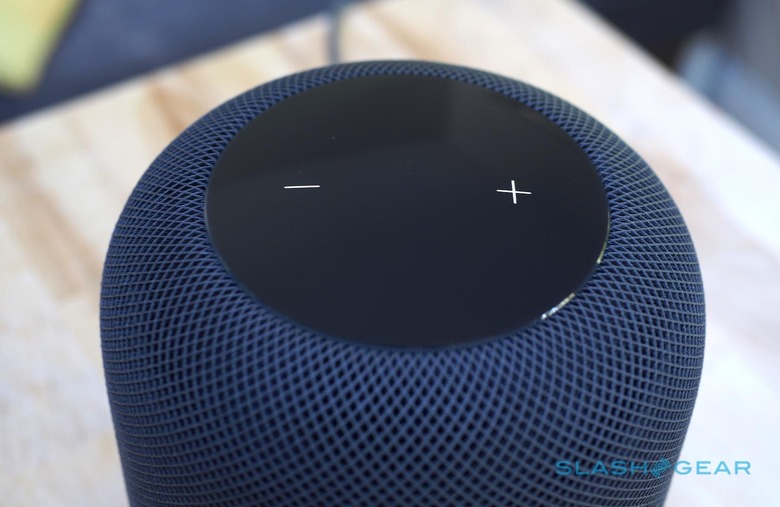
You can spend a small fortune on high-end audio equipment but, if you don't set it up correctly, still get a lackluster listening experience. In traditional terms that usually means at least a few hours of configuration and tuning. In HomePod's case, it's a few seconds of fully-automated spatial awareness.
As soon as you start playing music, HomePod begins figuring out what the room is like and whereabouts it's placed. Using its microphones, it listens out for how the song you're listening to reflects off the walls and other surfaces in the room, tuning itself accordingly. Put it in the middle of an open space and it'll fire out audio 360-degrees around itself; put it on a sideboard or shelf, and HomePod will process the different elements of whatever's playing in real-time, then uses its precise control of each tweeter to make sure the vocals end up central in the room while the backing track is more dispersed, or whatever sounds right for the music at hand.
Apple isn't the only company doing this sort of tuning – Sonos has something similar, involving you walking around the room with your iPhone while their speakers play a series of tones – but it's certainly come up with the easiest process for the end-user. Not only does HomePod do it initially all of its own accord but, courtesy of an accelerometer, it'll repeat that tuning all over again if you reposition the speaker somewhere else.
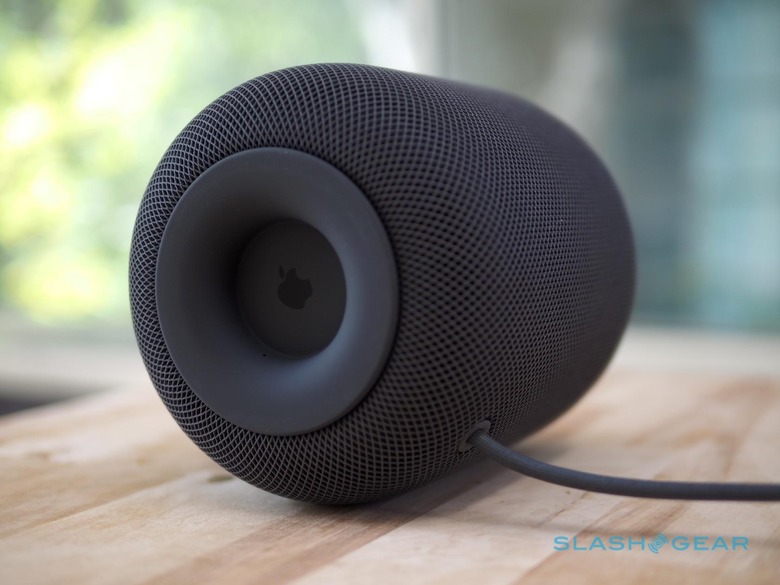
In typical Apple fashion, you don't get any say in the process. There's no way, for example, to turn this spatial awareness tuning off and hear the unprocessed result. Nor, indeed, are there any EQ or manual tuning controls: you can adjust the volume up or down, yes, but there's not so much as a treble/bass slider in the settings. Apple's argument is that, because HomePod is constantly adjusting itself based on what you're playing, traditional manual EQ modifications would be pointless. Fair, though small consolation if you simply prefer a little less thump in your music but can't actually tweak your HomePod overall to reflect that. You either like Apple's taste in tuning, or you buy a different speaker.
Happily, then, Apple's taste is pretty damn good. Given the focus on the tweeters and woofer, it comes as little surprise that the high and low end particularly shine. Vocals get a brightness that stays on the crisp side of harshness, while there's an unexpected rumbling richness to the low-mids and bass.
As you crank up the volume, meanwhile, HomePod keeps a constant eye on the bass to make sure it's not distorting. Depending on the track you're listening to, that can actually end up robbing the low-end of some of its thump, as HomePod's DSP trims the levels to prioritize clarity over raw power. Ironically, therefore, the maximum volume from the speaker can sound less impressive when it comes to room-filling.
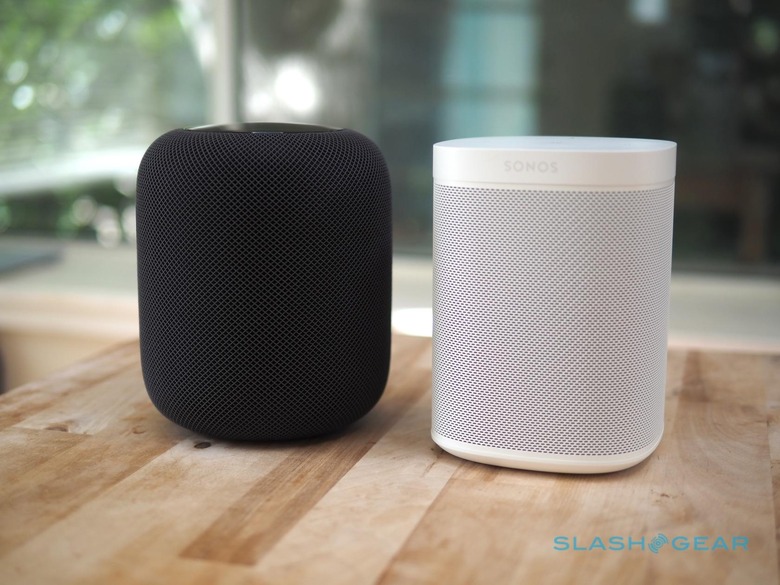
A regular Google Home or Amazon Echo – even the Echo Plus – can't hold a candle to HomePod's sound. They're tinny, underpowered, and sound generally muffled. I've not spent sufficient time with Google Home Max to make a clear comparison, but as a long-time Sonos user I was mighty intrigued to hear how Apple's speaker compared.
The $349 HomePod slides into the gap between Sonos' $249 PLAY:3 and $499 PLAY:5. Arguably its most obvious comparison, however, is the $199 Sonos One; that offers native Alexa voice control, though the company's other speakers can wirelessly connect to an Echo to be similarly controlled by spoken command, albeit not for Apple Music. A current bundle offer, meanwhile, includes two Sonos One units for a HomePod-matching $349.
Against a single Sonos One, the HomePod was the clear victor. Apple's speaker was unsurprisingly more full-throated, overpowering its rival handily. With two Sonos One in stereo configuration, however, the comparison got tighter. HomePod still had more bass, but the Sonos' setup's mids were clearer. Pushed to their upper volume limits, Apple's speaker avoided the tendency to shrillness that became noticeable on the twinned Sonos One with some tracks. Yet the clean stereo separation from using two individual speakers can't be understated, with Sonos offering a wider soundstage.
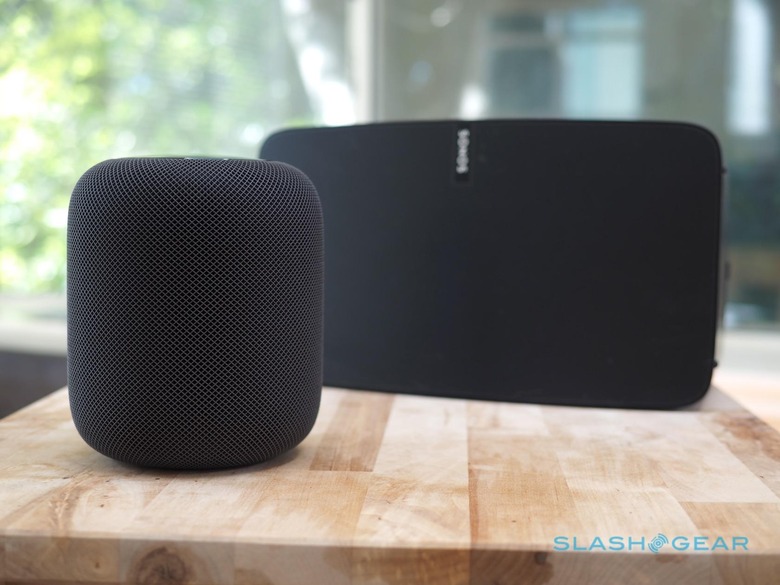
Compared with the well-esteemed PLAY:5, meanwhile, each speaker showed its advantages. The PLAY:5 is far more directional: it has a sweet spot – or, more accurately, a sweet cone – within which it sounds its best. Sit me in that prize position and I prefer how the Sonos speaker sounds.
Stray outside of that zone, though, and the clarity drops off noticeably. In contrast, wander around the HomePod while it does its thing, and the consistence of the sound quality is frankly astonishing. I was able to walk across the room, passing the HomePod in the process, and songs sounded effectively the same continuously. With the PLAY:5, there was a stark change in how the music sounded depending on where I was in relation to the speaker.
Apple Music, AirPlay, and nothing else
In a sea of connected speakers each trying to be as flexible as possible with what they'll play, HomePod is an outlier. The concept of owning it but not being an Apple Music subscriber is so outlandish as to be ridiculous. If you have a vast iTunes library to stream that would, I suppose, be one reason. All the same, users of other streaming services should know that they'll be treated as a second-class citizen.
HomePod can play your Spotify music, or your Pandora stream, or your favorite iHeartRadio station. If there was a way for the speaker to grimace as it did so, though, it would. Whereas Apple Music gets native support, including voice searches for artists, tracks, albums, and playlist genres – down to "upbeat 80s pop" or "dinner party music" – if you want any other source you're going to have to use AirPlay. That, while it works, just isn't as elegant.
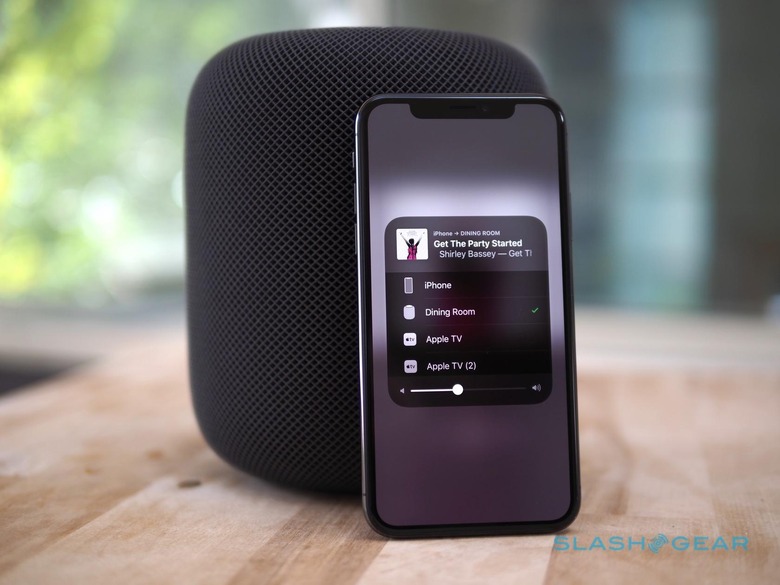
Just about anything audio-wise you can play on your iOS or macOS device, you can stream to HomePod via AirPlay. It's 16-bit 44.1Khz, so it's not like it sounds inherently bad or anything, either, and if whatever source you're playing has EQ controls you can adjust those in advance of HomePod getting its hands on the signal. But, while Apple Music is self-contained within HomePod, the experience of using Spotify or any other thirty-party source feels much more akin to an old, simple Bluetooth speaker. There are the basics of play/pause and track skipping by voice, but everything else you control from your phone – complete with a little lag as the system catches up to your commands.
If you're an Apple Music user, you probably won't care. If though, like me, you've historically been a Spotify user, the HomePod experience won't be so fun. I can ask for my Spotify Discover playlist by name with a Sonos One, or an Amazon Echo, or a Google Home; with Apple's speaker, I have to go old-school and choose it manually from the app. Apple doesn't even make it easy to import your Spotify playlists and recreate them in Apple Music.
The other big use for AirPlay is pairing HomePod with an Apple TV. That way, rather than relying on your – typically weedy – TV's speakers, you can use HomePod's audio instead. Unfortunately you can't switch to Apple TV audio on HomePod via a Siri voice command – you'll need to select it manually each time.
Smart, sorta
With all those microphones, it should come as no surprise that Siri is an excellent listener on HomePod. Even so, just how much background noise – or, indeed, loud music playing on the speaker itself – Apple's assistant can ignore to pick out the "Hey Siri" trigger phrase is impressive. Considering how much you'll be using it, that's only a good thing.
HomePod's top panel caters for the basics. Tap the center briefly, and it toggles play/pause; double-tap, and HomePod skips forward a track, while a triple-tap skips back one. Plus and minus buttons handle volume, while a long-press in the middle starts Siri listening. When you do the latter – or, indeed, when you say "Hey Siri" – you get a ripple of colors that glow through the panel, courtesy of a cluster of LEDs underneath.
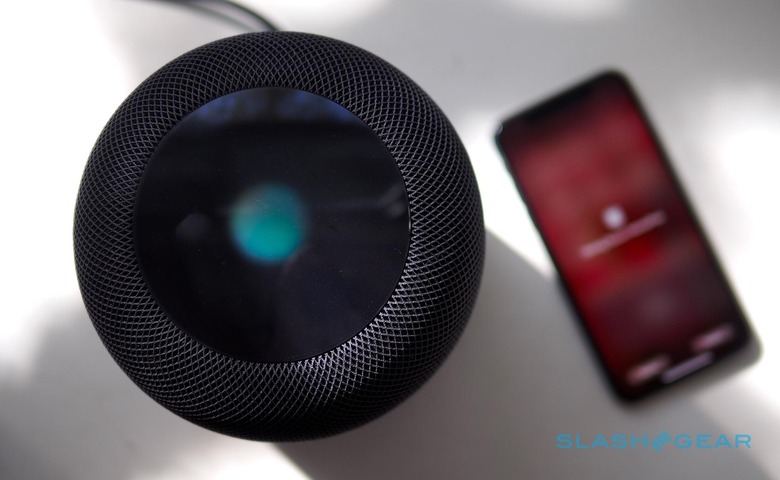
Siri runs on the same Apple A8 chipset that launched inside the iPhone 6 back in late 2014. It's powerful enough that HomePod can do local processing of the "Hey Siri" trigger phrase without constantly streaming audio to the cloud. The rest of your commands are processed remotely, though Apple does so with an anonymized Siri ID through an encrypted channel. The upshot is that, while the servers may know what's been asked for, Apple can't connect that request with your HomePod specifically.
For musical purposes, and with the aforementioned Apple Music proviso, Siri works well. You can either go for specifics, asking for a particular artist, album, or song, or play things fast and loose by genre or just a general mood. "Hey Siri, turn it down" controls volume just as well as the more precise "Hey Siri, set the volume to 50-percent." Apple's assistant can give track, artist, and album information too.
Currently, HomePod only supports a single Apple Music account. That's not a problem if you're the only person using the speaker but, if you live in a household with eclectic tastes, you'll probably want to turn off the "Use Listening History" option in the settings. Otherwise, whatever is played will shape your song recommendations, even if someone else asked for it.
That single person relationship gets more frustrating outside of music, meanwhile. HomePod can send messages and read out incoming messages, as well as set reminders and tasks, and create or add to notes, but only to a single account – and only if your iPhone is on the same WiFi network at the time. Unlike the Google Assistant, Siri on HomePod can't differentiate between voices and thus switch to the appropriate profile.
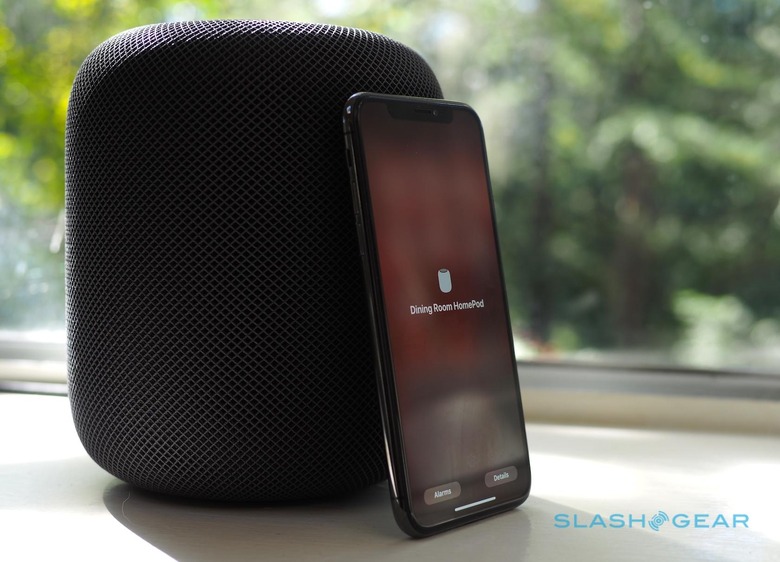
It means that, not only is message support and the rest only useful for one person in the household, but anybody talking to Siri can send a message under that person's name. Sure, you can turn it off, but then nobody gets to use it. It's an oddly awkward system, just like not being able to start hands-free speakerphone calls from HomePod, but instead having to dial them on your iPhone first and then manually transfer the audio to the speaker.
It's not my only frustration with how HomePod and my iPhone interact. Ask Siri to find a coffee shop or store, for example, and HomePod can read out not only the opening times but Yelp ratings and distance. Unfortunately you can't then say "Send that to my iPhone" to pull up directions and, unlike Amazon's Alexa app, there's no on-phone record of recent HomePod questions and answers.
Controlling HomePod playback from your iPhone is oddly awkward, too. Play music on a Sonos speaker from your phone and you'll get lock screen controls for it, yet if you want to control HomePod you need to open the Control Center, tap AirPlay, and then scroll down to the speaker's widget underneath the local playback buttons.
The biggest shortcoming, though, is the fact that Siri simply doesn't seem to handle general knowledge questions and other queries as smoothly as the Google Assistant or Alexa do. Part of that is by design: Apple specifically limited what Siri can do on HomePod versus what it can manage on an iPhone or Apple Watch. There's no calendar support, for example, and you can only set a single timer; while you can set multiple reminders as a workaround, that's only the case if you've enabled personal requests and thus opened up your messages and to-do list to everyone else within HomePod's earshot.
Eventually, Apple promises, we'll see more third-party integration. That relies on SiriKit, and right now there are a small handful of services which you can interact with through the speaker: Evernote, OmniFocus 2, and Remember The Milk, among others. Nonetheless it's clear that HomePod has a long way to go if it wants to catch up with Alexa's lengthy list of third-party skills and integrations.
A speaker that's a smart home hub
If you've already got smart home devices like connected lights, thermostats, switches, or other gadgets set up on your iPhone, HomePod will automatically add the ability to control them by voice. Just like an Apple TV, meanwhile, it'll also act as a hub for Apple's HomeKit system, allowing you to remotely control those connected devices even while you're away. You can access individual accessories specifically, or group them into scenes so that by saying "Hey Siri, good morning" your blinds open, the kitchen lights turn on, the coffee maker starts brewing, and the foghorn you use to lure sailors onto the rocks starts its baleful moan. Assuming, that is, you've got them all wired up to begin with.
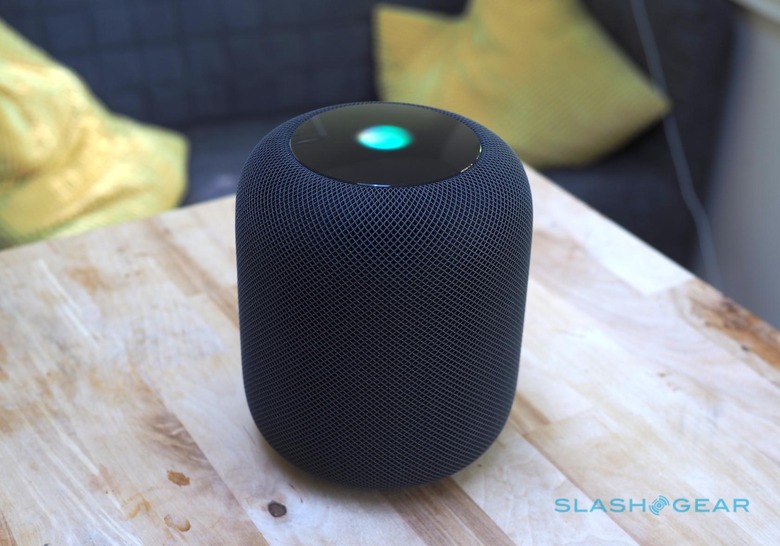
I have a mixture of HomeKit-compliant and non-compatible devices set up, and some work was involved pruning the collection to work smoothly with HomePod. Device names that I recognize on-screen, for example, don't necessarily make the same amount of sense when you're asking for them to be triggered out loud.
Apple's strict stance on smart home security has proved a double-edged sword. On the one hand, HomeKit is arguably far safer in its architecture than other home automation platforms out there. The flip side to that, though, is that HomeKit adoption has been slower than rival systems.
That ought to change come iOS 11.3, which among other things will add software-based HomeKit authentication. For connected home device-makers, building in HomeKit support should become a lot more straightforward at that point. Hopefully, that will mean the market for accessories will flourish.
A work in progress
There's no denying that Apple came late to the smart speaker market. Sonos has been making connected, multi-room speakers for years now. Amazon's Echo has several years' head-start on HomePod, as does Google Home. And, even with a few months delay to its launch, Apple's speaker arrives with a few key features still on the roadmap.
Later this year, an update will allow two HomePod speakers to be linked together into a stereo pair. I had a brief demo of how that will sound and, though it wasn't enough to make any sort of final judgement, it did nothing to shake my expectation that it will leave HomePod sounding louder and with much improved stereo separation. Of course, it'll also cost you $700 all-in.
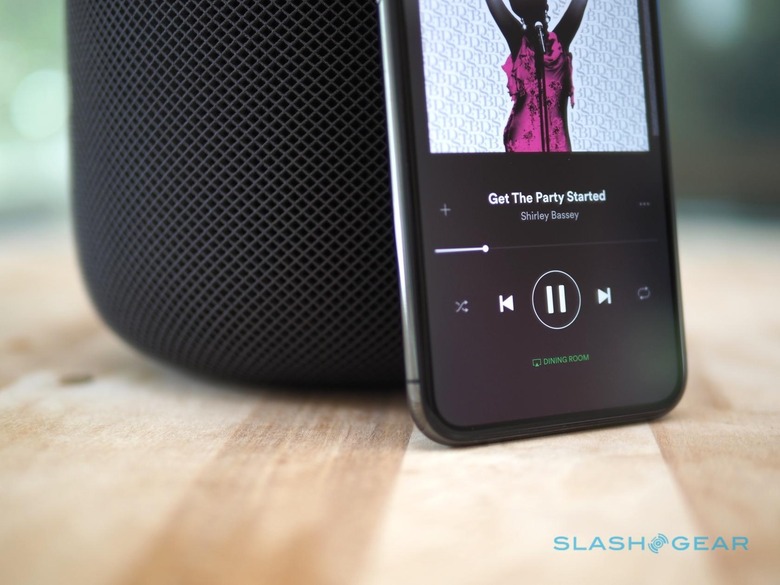
At the same time, Apple will also release AirPlay 2 for HomePod. At that point you'll be able to do multi-room audio, synchronizing a single track over HomePod speakers in different rooms. Notable, Apple isn't the only company promising AirPlay 2 compatibility: in theory, you'll be able to link select connected speakers from Sonos and others into the same multi-room configuration with your HomePod.
They're the obvious omissions, but there are others too. It's unclear if you'll be able to use multiple HomePod speakers as a surround sound system with your TV; assuming, that is, you could stomach the combined price tag for so equipping a single room. More mundane, there are no provisions for mounting the speakers on a wall, since Apple didn't see fit to include standard screw fittings.
Finally, if voice is to be the route to content discovery in future, then I can't help but feel like podcasts have been left out. Apple Music has curated playlists for songs, but if you don't have a specific podcast in mind that you want to listen to, you're basically on your own when it comes to researching what's out there. Being able to ask "Hey Siri, find me a podcast on classic cars" and get some top-rated suggestions would be a useful addition to the assistant's talents.
Wrap-up
Apple has made an astonishingly good speaker. They've made a great voice-controlled speaker, too. Question is, have they made a great smart speaker?
There I'm not so convinced, at least as HomePod exists today. If you're looking for a fantastic Apple Music speaker with clean, easy to use voice control, your $349 gets you a much slicker experience than anything else out there on the market, and great sound too. Yet beyond navigating Apple's own streaming service, Siri pales in comparison to what Alexa or the Google Assistant can do.
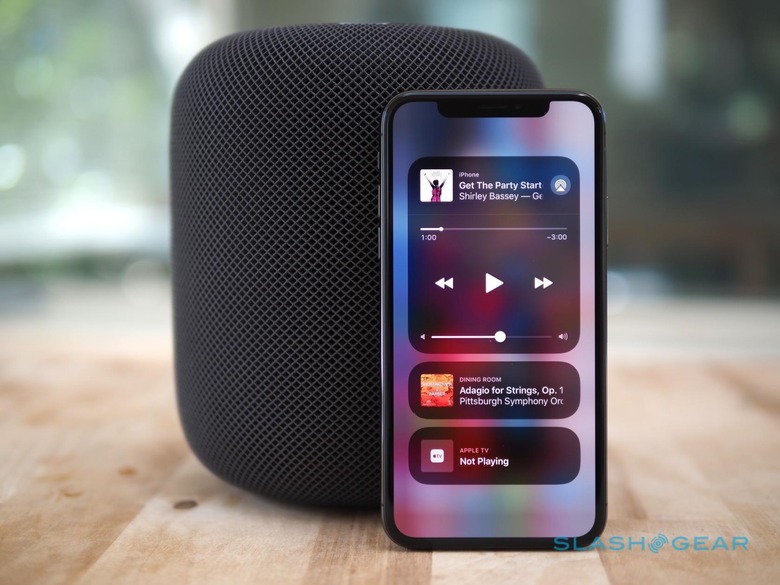
Here's the thing, though. HomePod's failings, or shortcomings, are all software, and if there's one thing the smart speaker segment has demonstrated it's that you can do vast amounts to improve things – either remotely in the cloud or via firmware updates – if you're of a mind to do so. It took Apple seven years to design the HomePod's hardware; in one year, if it felt so motivated, it could be unrecognizable in terms of the speaker's functionality.
Right now, only those fully committed to the Apple ecosystem should consider HomePod. It sounds much better than it looks like it should, and its ease of use at music playback are unparalleled among smart speakers. Apple achieves that, though, with the tightest integration with its own services that we've seen in a while from the company, to the effective exclusion of everything else. Only time will tell if it has any interest in changing that.
